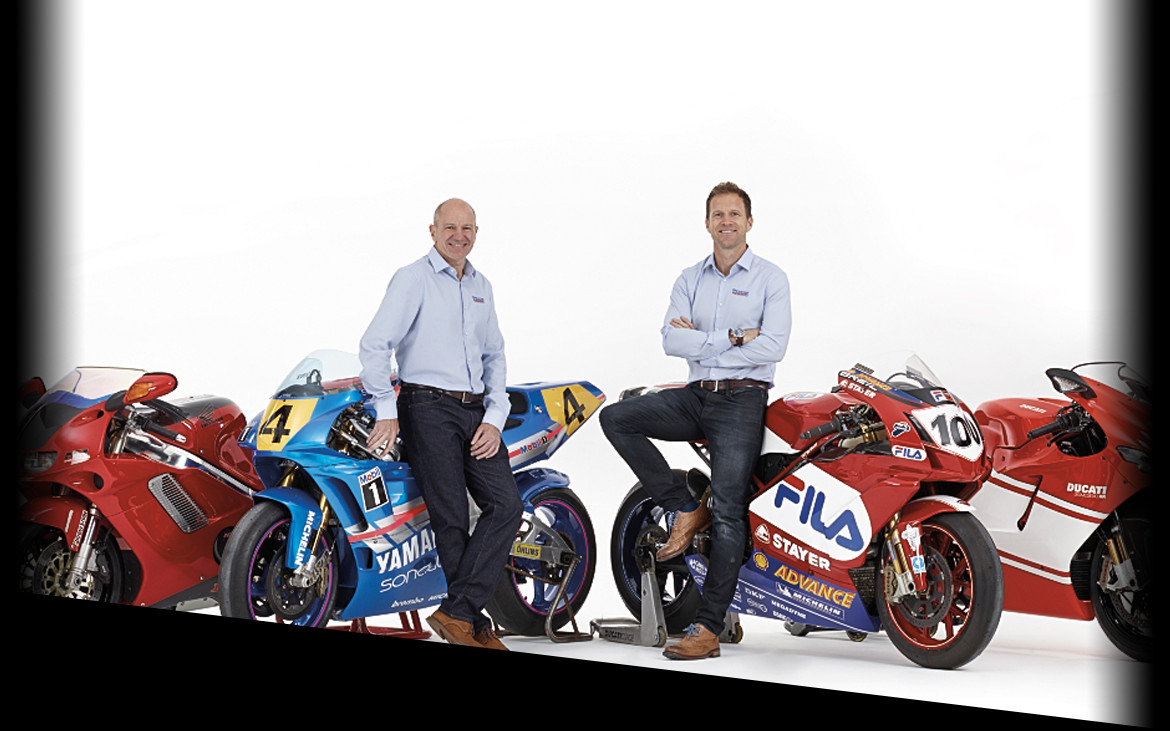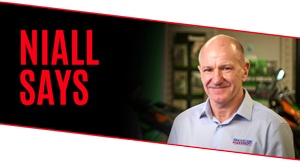
0333 0053 100

0333 0053 100


“I first became aware of Aprilia in 1985, during my first full season of 250cc Grand Prix. The Italian manufacturer entered a Rotax-powered machine with Loris Reggiani on board, and he came flying past me on many occasions. Thankfully
my skills improved, as did his when he won Aprilia’s first ever 250 GP at Misano in 1987. The brand has grown substantially since the eighties not least as they are very good at producing highly desirable motorcycles.
“I’ve actually owned an Aprilia Climber Trials bike and a few gorgeous RS125 race replicas that were mostly used by my boys for racing in the Aprilia Superteen Championship. Nice as they all were, it is probably no surprise my ultimate machine is the RSV4. I’ve ridden quite a few over the years and loved every second.
"The fun always starts with the growl of that wonderful big V4 motor but, once rolling, the RSV’s world superbike championship winning DNA takes over. The slick gearbox, superb handling, and compact riding position is fine on the road, but you can tell this bike’s real home will always be on the racetrack.”

“I always wanted to race a factory 250 Aprilia. Throughout the '90s it was the bike to be on and all the great 250 boys at the time rode their exotic looking bikes. Reggiani, Biaggi, Capirossi, Harada, and Rossi all won races and
championships for the factory. There was just something special about them. They looked, sounded and even smelt beautiful. If you’d managed to buy an old factory bike back then it would be worth 10 times what you paid now, as they’re
a sought after bit of kit.
"I’ve been lucky enough to test the latest RSV4 1000cc road bikes a few times for MCN, on road, and on track. They always have a distinctive feel to them, well-balanced smooth and easy to ride. On the track, I found it really deceptive as the lap times were much faster than it felt.
"Compare it to, say, the BMW S1000 RR where you know you are doing a good lap time. The feeling with the Aprilia was that you could be on lap record pace with one hand on your hip. I guess this demonstrates just how good the bike is.”
Niall Mackenzie and Neil Hodgson are two of the most recognisable names in world of biking and are now bringing their expertise to the Motorbike Insurance world.
Aprilia provide a wide range of motorbikes, from the Aprilia RSV4 sports bike to the Tuono 125. Getting Aprilia motorcycle insurance through Mackenzie Hodgson couldn’t be easier either online or on the phone.
We will try to find you the right insurance for you and your bike, taking every step to ensure that you get a suitable quote.
When Ivano Beggio took control of Aprilia in 1973 at the age of just 29, following the death of his father, the firm from northern Italy employed 18 people and built only bicycles. By 1996, the Aprilia name was known around the world for its motorcycles and scooters, and had humbled mighty Honda with a string of world titles in the 125 and 250cc Grand Prix classes.
Beggio’s firm was one of the world’s most dynamic and fastest-growing manufacturers in the Nineties. Scooters and small bikes provided the bulk of the sales and profit, with racy two-stroke singles including the Futura 125 and RS125 among the best in their class. The Pegaso 600 was a classy dual-purpose model; the Motò 6.5, shaped by French design star Philippe Starck, was distinctive and garnered headlines beyond the traditional motorcycle media, even if sales for the big single were less successful.
The bike that probably best summed-up Aprilia was the RS250. Essentially a roadgoing replica of the racebike on which Max Biaggi had won the 1994 250cc world championship, the RS combined a high-revving two-stroke engine with a massive twin-beam aluminium frame, top-class cycle parts and streamlined, racetrack-inspired styling.
Its engine was a reengineered version of the V-twin from Suzuki’s RGV250, and produced 70bhp. With its aggressive riding position, peaky powerplant and ultra-light weight, the RS came closer than any other bike to providing grand prix style thrills on the road. It was good for 130mph, and its superb suspension and powerful brakes made it fast and fun on road or track.
Aprilia proved difficult to beat in GP racing in 1994, winning both the 250 and 125cc world titles with Biaggi and Japan’s Kazuto Sakata. Beggio attributed much of his firm’s success to an unusual policy of manufacturing virtually no components in-house. Instead, Aprilia relied on a network of suppliers for parts that were assembled at his factory in Noale, near Venice. Over a quarter of Aprilia’s 500 strong workforce was employed in racing, or in research and development.
Aprilia’s next big step came in 1998, when the firm became a superbike manufacturer with the launch of the RSV Mille. Powered by a 998cc V-twin engine with cylinders at 60 degrees, the Mille was designed as the basis for a World Superbike racer. Its bodywork was shaped in Aprilia’s wind tunnel; its aluminium twin-beam frame designed by race department engineers.
The 128bhp motor was superb: strong at the top end, torquey in the midrange and with plenty of V-twin character. And the chassis was equally impressive, combining high speed stability with light, responsive steering. The RSV Mille was a fine first effort that succeeded in establishing Aprilia as a serious superbike manufacturer. On the track it won world superbike races, mostly through Japanese ace Noriyuki Haga, without quite threatening Ducati’s dominance of the championship.
Starting in 2002, the factory also made a short-lived attack on the even more competitive MotoGP championship, with an innovative 990cc three-cylinder machine, the RS3, that used pneumatic valves to rev to 17,000rpm. But riders including Haga and former world superbike champion Colin Edwards were uncompetitive on the powerful but hard-to-ride triple, called the RS Cube. Brits Shane Byrne and Jeremy McWilliams also enjoyed, for want of a better word, a season on the savage triple before it was shuffled off the grid after the 2004 campaign.
By contrast the RSV became a success in showrooms worldwide, and was soon developed to give a range of V-twin roadsters. These included the more sports-touring oriented Falco, which was followed by a purpose-built long-distance model, the Futura, with striking angular bodywork. Neither sold particularly well but Aprilia hit the mark in 2002 with a naked version of the RSV, the Tuono – “Thunder” in Italian.
The Tuono blended the RSV’s familiar 998cc V-twin and aluminium beam frame with a one-piece handlebar that gave a more upright riding position. Aprilia added a small headlamp fairing to divert some wind, and didn’t detune the 130bhp powerplant. The result was a fast and thrilling bike that earned a strong following.
Both RSV and Tuono were updated in subsequent years, the most important change coming in 2003, when the super-sports model was effectively replaced by a redesigned V-twin featuring less radical styling and a more compact chassis. Aprilia’s successful policy of offering a competitively priced upmarket version of the standard RSV, incorporating parts including Öhlins suspension and lightweight forged wheels, continued with the RSV Factory.
All seemed to be going well at Aprilia, as the company expanded by buying two longer established but struggling Italian marques, Laverda and Moto Guzzi. But it soon became clear that boss Beggio had been too ambitious, and lacked the resources to withstand a downturn in the Italian scooter market. Production in several factories was suspended amid large debts. Beggio was forced to relinquish his position of President, and in December 2004 Aprilia was taken over by scooter giant Piaggio.
Under Piaggio’s control the future appeared bright for Aprilia, whose new owners announced plans for an ambitious range of 20 new bikes over the next three years, backed by substantial investment. Notable models included the Shiver, an all-new 750cc V-twin roadster, and the Mana, an 850cc roadster with an automatic gearbox.
The super-sports RSV4 was first seen as the world superbike racer on which Aprilia works rider Max Biaggi was immediately competitive in the 2009 championship. Such was the V4’s speed and exotic chassis design that rival teams complained it was a pure competition machine, not a modified production bike as the regulations demanded. Shortly afterwards Aprilia unveiled the production RSV4 Factory, and the critics were forced to back down.
Engineers from Aprilia’s streetbike and racing departments had collaborated in the RSV4’s design, which was based on a 999cc DOHC V4, with cylinders set at 65 degrees. The chassis used a twin-spar aluminium frame that incorporated an unprecedented degree of adjustability. The RSV4 produced 180bhp in street spec and was fiercely competitive on both road and track, winning three world superbike titles (with Biaggi, twice, and Sylvain Guintoli) without generating the sales that its performance deserved.
Aprilia had more showroom success with the naked Tuono V4R derivative, which was launched in 2011 and followed the super-sports model by offering a state-of-the-art APRC electronics package. Its barely detuned V4 engine made 167bhp, taking super-naked performance to a new level – subsequently raised still further in 2015 with the Tuono V4 1100.
The RSV4 has also been updated several times to good effect, notably with the adoption of the larger, 1078cc engine, which raises maximum output to 217bhp and requires fairing winglets to keep the front wheel down. Aprilia has changed a lot since the days when it built just small-capacity two-strokes, but the Italian firm’s emphasis on performance, competition and excitement remains intact.